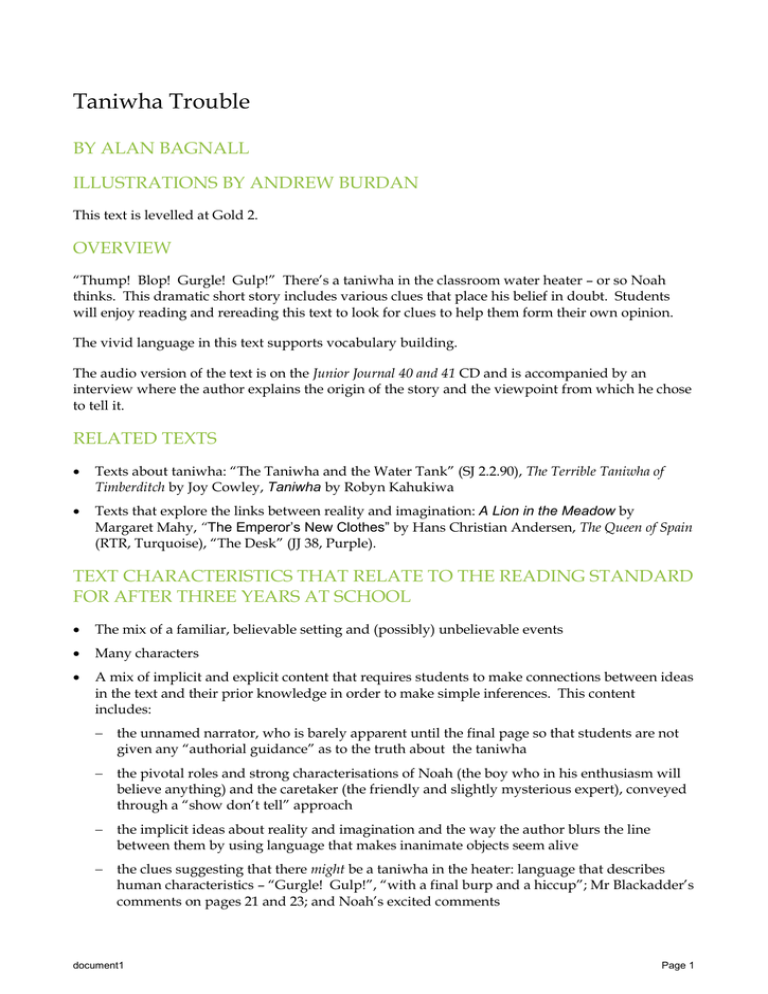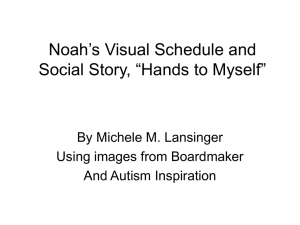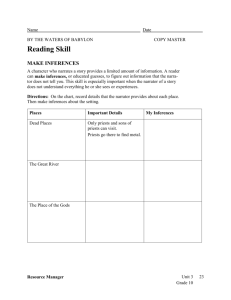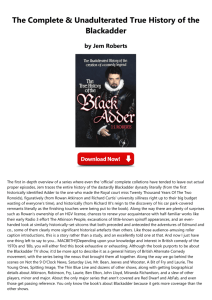Taniwha Trouble (Word 2007 31KB)
advertisement

Taniwha Trouble BY ALAN BAGNALL ILLUSTRATIONS BY ANDREW BURDAN This text is levelled at Gold 2. OVERVIEW “Thump! Blop! Gurgle! Gulp!” There’s a taniwha in the classroom water heater – or so Noah thinks. This dramatic short story includes various clues that place his belief in doubt. Students will enjoy reading and rereading this text to look for clues to help them form their own opinion. The vivid language in this text supports vocabulary building. The audio version of the text is on the Junior Journal 40 and 41 CD and is accompanied by an interview where the author explains the origin of the story and the viewpoint from which he chose to tell it. RELATED TEXTS Texts about taniwha: “The Taniwha and the Water Tank” (SJ 2.2.90), The Terrible Taniwha of Timberditch by Joy Cowley, Taniwha by Robyn Kahukiwa Texts that explore the links between reality and imagination: A Lion in the Meadow by Margaret Mahy, “The Emperor’s New Clothes” by Hans Christian Andersen, The Queen of Spain (RTR, Turquoise), “The Desk” (JJ 38, Purple). TEXT CHARACTERISTICS THAT RELATE TO THE READING STANDARD FOR AFTER THREE YEARS AT SCHOOL The mix of a familiar, believable setting and (possibly) unbelievable events Many characters A mix of implicit and explicit content that requires students to make connections between ideas in the text and their prior knowledge in order to make simple inferences. This content includes: the unnamed narrator, who is barely apparent until the final page so that students are not given any “authorial guidance” as to the truth about the taniwha the pivotal roles and strong characterisations of Noah (the boy who in his enthusiasm will believe anything) and the caretaker (the friendly and slightly mysterious expert), conveyed through a “show don’t tell” approach the implicit ideas about reality and imagination and the way the author blurs the line between them by using language that makes inanimate objects seem alive the clues suggesting that there might be a taniwha in the heater: language that describes human characteristics – “Gurgle! Gulp!”, “with a final burp and a hiccup”; Mr Blackadder’s comments on pages 21 and 23; and Noah’s excited comments document1 Page 1 The clues that the taniwha doesn’t really exist: “Hot water snakes up … into our heaters” (page 18); “Noah says he [Mr Blackadder] can even roll a soccer ball off the roof by whistling to it” (page 20), from which readers can infer that Noah will believe anything; the fact that Mr Blackadder goes to the boiler room alone and later takes the jar away quickly (pages 21 and 22); and the final question: “Was I the only one who didn’t see the little taniwha in the jar?” the vivid imagery, created with descriptive verbs, adjectives, nouns, adverbs, and a simile (“like a dungeon”) that helps readers visualise and engage in the “world” of the story, for example: “Thump! Blop! Gurgle! Gulp!”, “buck, shudder, and shake”, “snakes up from below”, “coils into our heaters”, “burping and rumbling” (page 18); “deep under the school in the boiler room”, “a great roaring furnace and a maze of pipes, taps, and dials” (page 20); “the struggling noises grew softer”, “inky, black water” (page 21); and “dark, muddy water”, “murky and black” (page 23). Other unfamiliar words, for example, “Blackadder”, “Pinkney”, “hiccup”, “reckoned”, “Waiwhetū” Ideas and information organised in paragraphs A variety of sentence structures, including complex sentences Frequent use of dialogue. SUGGESTED READING PURPOSES (What can the students expect to find out and/or think about as a result of reading this text?) To find out what the taniwha trouble is and decide whether they agree with the characters’ points of view To enjoy and explore the author’s use of language to create vivid images SETTING A LEARNING GOAL (What opportunities does this text provide for students to learn more about how to “read, respond to, and think critically about” texts?) To meet the reading purpose, students need to draw on a range of comprehension and processing strategies, often simultaneously. Select and adapt from those below to set your learning goal. Be guided by your students’ particular needs and experiences: who they are, where they come from, and what they bring (Reading and Writing Standards for Years 1–8, Knowledge of the learner, page 6). This text provides opportunities for students to: visualise the action as they read, noticing the words that create images and sounds in their minds infer what is happening and what the characters are like by noticing clues in the text use word-solving strategies to decode and/or work out the meaning of unfamiliar words and phrases say whose viewpoint they agree with and why (evaluate). document1 Page 2 INTRODUCING THE TEXT Discuss taniwha and the students’ ideas about what they are like, making connections to stories the students have read or heard. Keep a neutral stance around whether taniwha are real or not. English language learners could share the words used for dragons or other such creatures in their first languages. Look at the title and accompanying illustration to establish the classroom setting. I wonder what taniwha trouble in a classroom might be? Share the reading purpose and the learning goal (how they will achieve the reading purpose, for example, by visualising and inferring). Tell the students that the author deliberately creates questions in the mind of the reader and that they will need to look for clues and “read between the lines” to decide the answers for themselves. READING AND DISCUSSING THE TEXT Below are some behaviours you could expect to see as the students read and discuss this text. Each example is accompanied by suggested instructional strategies you can use to scaffold their learning. Select and adapt from the suggestions according to your students’ needs and experiences. The students notice key words and phrases and use them to create images and sounds in their minds as they read (visualise). Encourage the students to use their imaginations as they read. What can you see? What helped you to build that picture? Model some responses to page 18 (This makes me think of …), like those in the graphic organiser below. Then let the students continue in pairs, completing the organiser during or after reading. I can see … What makes me see that a wild taniwha banging around in the heater, making a lot of noise “Thump! Blop!” “buck, shudder, and shake” “There’s a taniwha in the heater!” The boy pointing at the heater in the illustration water twisting through the heater, a bit like in a hose “snakes up … coils into” The students use clues in the text to make inferences about what is happening and what the characters are like. Some characterisation is explicit, but much of it is implicit. Model some inferences to guide your students. On page 20, Noah says that Mr Blackadder can roll a soccer ball off a roof by whistling. I don’t believe that – but if Noah believes it, then I’m beginning to get a feeling for the sort of person Noah is. Or, on page 21, draw attention to “Gradually the struggling noises grew softer.” I’m wondering why. I’m guessing he’s solving the problem. What do you think he’s referring to when he says “Got it!”? If you need to support inferences about Mr Blackadder, draw attention to where he works: “deep under the school … It’s like a dungeon” (page 20), and what he says and how: for document1 Page 3 example, “It’s a taniwha all right” and “he said proudly” (page 21). What do these things suggest about him? Prompt the students to use the information on pages 22 and 23 to check and refine their inferences about the action and characters. Encourage them to make connections with their own experiences. The students use word-solving strategies to decode and/or work out the meanings of unfamiliar words and phrases. If your students need support with unfamiliar words like “burbling” and “gurgling”, remind them of the strategy of removing “ing” to get the root word. You could refer to a common example like “bubble”. Discuss how many of these words for sounds mimic the sounds themselves (onomatopoeia). Prompt the students to look out for other examples. In other cases, notice whether your students use context clues to work out word meanings, for example, the simile of a dungeon to describe the boiler room (page 20). If not, support them to do so: I’ve noticed that the narrator compares this room with something … The students state whose viewpoint they agree with, backing their opinion with evidence. Refer to the final question. Do you think there was a taniwha in the jar? Why or why not? Speculate on why the author included the question. Did the other children really see the taniwha? What about Mr Blackadder? If the students say “no”, ask What made them say they did? Encourage them to make connections to their own experiences of getting caught up in the thrill of a situation. Reread to explore the evidence for and against the taniwha’s existence. (The students will have done some of this work already in making inferences about the characters.) Have the students notice in particular the description of the heater on page 18 (paragraph 2). Prompt them to notice how Mr Blackadder does all the “taniwha catching” on his own. The students should be able to back up their final opinion with evidence. AFTER READING The students can reread the story while they listen to the audio version on the Junior Journal 40 and 41 CD. They can also listen to the interview with the author, to find out where he got the idea for this story and why he chose to write it this way. Encourage the students to think critically by posing the question Who is the narrator? Have them reread to clarify. (Although the narrator isn’t shown until page 23, the use of the first person plural throughout indicates that he’s a student in the class and the reference to Noah on page 20 implies that he knows Noah well.) How might the story be different if Noah were the narrator? Suggest how the unknown narrator adds to the doubt about Noah’s view. The students can share with a partner any words they found difficult and the strategies they used to work them out. Listen to the discussions. Do you need to follow up on any decoding strategies, particular words, or features of words? The students could group words with similar meanings, including words for sounds. Explore in more detail the words and phrases used to create images and sounds in the text, identifying the descriptive verbs and adjectives and examples of onomatopoeia. Encourage the students to play around with language to create images. They could describe anything that interests them, true or imagined. You could have the students explore the meanings of the adverbs “Suddenly”, “Gradually”, and “Shortly”. Have them reread the relevant sections of text and think of other words or phrases (for example, “all at once”, “slowly”, and “soon”) that mean the same thing as the three adverbs above. document1 Page 4 The students can reread the text with a buddy while you observe their fluency and how they approach challenges in the text. document1 Page 5




